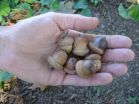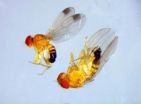(Press-News.org) Messier 9, pictured here, is a globular cluster, a roughly spherical swarm of stars that lies around 25 000 light-years from Earth, near the centre of the Milky Way, so close that the gravitational forces from the galactic centre pull it slightly out of shape.
Globular clusters are thought to harbour some of the oldest stars in our galaxy, born when the Universe was just a small fraction of its current age. As well as being far older than the Sun — around twice its age — the stars of Messier 9 also have a markedly different composition, and are enriched with far fewer heavier elements than the Sun.
In particular, the elements crucial to life on Earth, like oxygen and carbon, and the iron that makes up our planet's core, are very scarce in Messier 9 and clusters like it. This is because the Universe's heavier elements were gradually formed in the cores of stars, and in supernova explosions. When the stars of Messier 9 formed, there were far smaller quantities of these elements in existence.
Messier 9, as its name suggests, was discovered by the great French astronomer Charles Messier in 1764. Even through the most advanced telescopes of the day, none of the stars in the cluster could be seen individually. Messier, seeing only a faint smudge, therefore classified the object as a nebula — or "cloud" in Latin. It was only later in the 18th century that astronomers, most notably William Herschel, began to spot stars within the cluster.
The contrast between Messier's equipment and the tools at the disposal of today's astronomers is stark. Hubble's image, the highest resolution image yet made of Messier 9, is able to resolve individual stars, right into the crowded centre of the cluster. Over 250 000 of them are neatly focused on the detector of Hubble's Advanced Camera for Surveys, in an image which covers an area no bigger than the size of the head of a pin held at arm's length.
As well as showing the individual stars, Hubble's image clearly shows the different colours of the stars. A star's colour is directly related to its temperature — counter-intuitively, perhaps, the redder it is, the cooler it is; and the bluer it is, the hotter. The wide range of stellar temperatures here is clearly displayed by the broad palette of colours visible in Hubble's image of Messier 9.
Messier 9's neighbourhood is interesting too, and is marked by two vast and dark nebulae. These pitch-black clouds of interstellar dust are known as Barnard 259 (to the south-east of Messier 9) and Barnard 64 (to the west), and are clearly visible in wide-field images of the cluster.
INFORMATION:
Notes
The Hubble Space Telescope is a project of international cooperation between ESA and NASA.
Image credit: NASA & ESA
Links
- Images of Hubble: http://www.spacetelescope.org/images/archive/category/spacecraft/
Contacts
Oli Usher
Hubble/ESA
Garching bei München, Germany
Tel: +49-89-3200-6855
Email: ousher@eso.org
Glittering jewels of Messier 9
2012-03-19
ELSE PRESS RELEASES FROM THIS DATE:
'Gravity is climate' - 10 years of climate research satellites GRACE
2012-03-19
For the first time, the melting of glaciers in Greenland could now be measured with high accuracy from space. Just in time for the tenth anniversary of the twin satellites GRACE (Gravity Recovery and Climate Experiment) a sharp image has surface, which also renders the spatial distribution of the glacial melt more precisely. The Greenland ice shield had to cope with up to 240 gigatons of mass loss between 2002 and 2011. This corresponds to a sea level rise of about 0.7 mm per year. These statements were made possible by the high-precision measurements of the GRACE mission, ...
Exposure to antibiotics linked to severity of allergic asthma: UBC research
2012-03-19
Widely used antibiotics may increase incidence and severity of allergic asthma in early life, according to a University of British Columbia study.
The study, published today in the journal EMBO reports, shows that certain antibiotics that affect intestinal bacteria also had a profound impact on allergic asthma.
"It has long been suspected that kids exposed to more antibiotics – like those in developed countries – are more prone to allergic asthma," says the study's author, UBC microbiologist Brett Finlay. "Our study is the first experimental proof that shows how."
Finlay's ...
'Belfast Summit important in preventing Cyber World War' -- Eugene Kaspersky
2012-03-19
One of the world's leading Internet security experts, Eugene Kaspersky, has described the World Cyber Security Technology Research Summit at Queen's University Belfast as key in preventing a Cyber World War.
Eugene Kaspersky, CEO and co-founder of the largest antivirus company in Europe, Kaspersky Lab, will be giving a keynote address at the second annual Cyber Security Technology Research Summit on Friday 16 March.
The cyber security guru is joining some of the world's leading cyber security experts and government policy makers from around the world for a two-day meeting ...
Cell-signaling pathway has key role in development of gestational diabetes, says Pitt team
2012-03-19
PITTSBURGH, March 16 – Researchers at the University of Pittsburgh School of Medicine have identified a cell-signaling pathway that plays a key role in increasing insulin secretion during pregnancy and, when blocked, leads to the development of gestational diabetes. Their findings are available online today in Diabetes, one of the journals of the American Diabetes Association.
During pregnancy, pancreatic beta cells should expand and produce more insulin to adapt to the needs of the growing baby, explained senior investigator Adolfo Garcia-Ocana, Ph.D., associate professor ...
Meeting greater number of recommended cardiovascular health factors linked with lower risk of death
2012-03-19
CHICAGO – In a study that included a nationally representative sample of nearly 45,000 adults, participants who met more of seven recommended cardiovascular health behaviors or factors (such as not smoking, having normal cholesterol levels, eating a healthy diet), had a lower risk of death compared to participants who met fewer factors, although only a low percentage of adults met all seven factors, according to a study appearing in JAMA. The study is being published early online to coincide with its presentation at a specialty meeting of the American Heart Association.
"Cardiovascular ...
Lyme disease surge predicted for the northeastern US
2012-03-19
The northeastern U.S. should prepare for a surge in Lyme disease this spring. And we can blame fluctuations in acorns and mouse populations, not the mild winter. So reports Dr. Richard S. Ostfeld, a disease ecologist at the Cary Institute of Ecosystem Studies in Millbrook, NY.
What do acorns have to do with illness? Acorn crops vary from year-to-year, with boom-and-bust cycles influencing the winter survival and breeding success of white-footed mice. These small mammals pack a one-two punch: they are preferred hosts for black-legged ticks and they are very effective ...
Nano rescues skin
2012-03-19
Nanoparticles containing chitosan have been shown to have effective antimicrobial activity against Staphylococcus saprophyticus and Escherichia coli. The materials could be used as a protective wound-healing material to avoid opportunistic infection as well as working to facilitate wound healing.
Chitosan is a natural, non-toxic and biodegradable, polysaccharide readily obtained from chitin, the main component of the shells of shrimp, lobster and the beak of the octopus and squid. Its antimicrobial activity is well known and has been exploited in dentistry to prevent ...
Novel plastics and textiles from waste with the use of microbes
2012-03-19
New biotechnological and chemical methods will facilitate efficient production of chemicals, materials and fuels from renewable natural resources. The Academy of Finland Centre of Excellence (CoE) in White Biotechnology – Green Chemistry Research focuses on the research and development of microbial cells, or cell factories, for producing new useful compounds from sugars in plant biomass. These compounds can be used, for example, for manufacturing bioplastics or in medical applications.
"By means of gene technology, we can modify microbial metabolism and thereby produce ...
An invasive Asian fly is taking over European fruit
2012-03-19
Coming from the Asian continent, Drosophila suzukii has only been in Spain for a short time. Far away from slipping through into the Iberian Peninsula, it accelerated towards the north of Europe where it has already crossed the Alps. Amongst its preferred target are cherries and red fruits but any type of fruit is suitable for it to lay its eggs. This insect is posing a threat to the fruit of more and more European countries.
"Out of the 3,000 known species of Drosophilae, commonly named the vinegar fly, only two are potentially dangerous to fruit crops. One of them is ...
Survival of the fittest -- ESF hosts session on the challenges of life in extreme environments
2012-03-19
Have you ever wondered how life is sustained in environments like deserts, deep seas or the polar regions? How do organisms adapt and thrive in such harsh conditions, and what challenges do they face as a result of human activities and climate change, especially climate "extremization"? Shedding light on some of these issues is the objective of the European Science Foundation's (ESF) session on 27 March at Planet Under Pressure 2012. The session will look at different aspects of life in extreme environments - from knowledge to sustainable exploitation of new resources under ...


